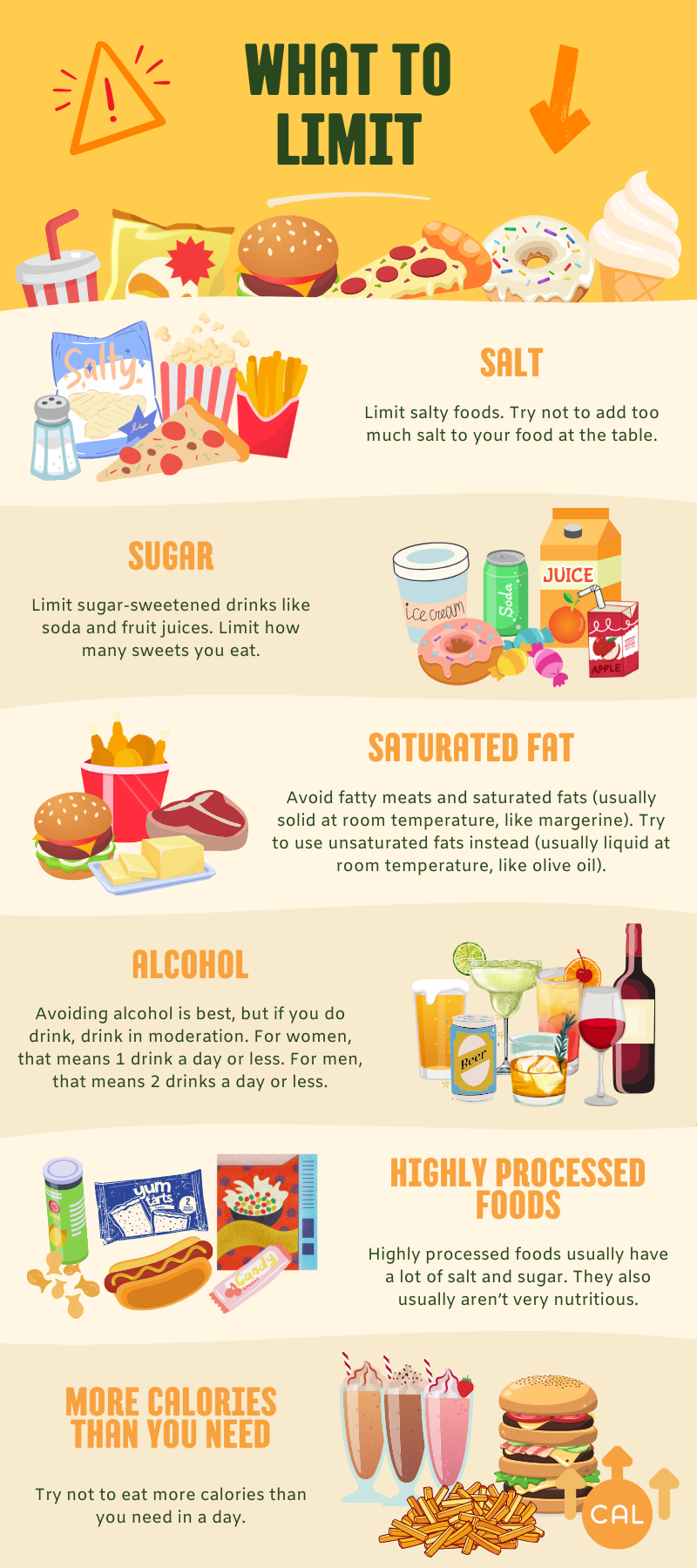There is no one recommended dietary pattern for optimal health.1 Recommendations for a healthy diet should be individualized with the overall goal of promoting and supporting healthy eating patterns, emphasizing a variety of nutrient-dense foods in appropriate portions to improve overall health. Any diet should maintain the pleasure of eating and only limit food choices when indicated by the literature. Experts caution against focusing on macronutrients, micronutrients, or single foods, but rather emphasize considering individuals’ overall diet.
The total number of calories a person needs each day varies depending on the person’s age, sex, height, weight, and level of physical activity.1 In addition, other factors such as underlying health conditions, whether someone is pregnant, and goals of losing, maintaining, or gaining weight, affect how many calories should be consumed. According to the Dietary Guidelines for Americans, estimated daily caloric needs for adult women are 1,600-2,400 and for adult men are 2,000-3,000.
According to the Dietary Guidelines for Americans, a healthy diet based on 2,000 calories of intake per day should be comprised of:1
- 5 cups of vegetables
- 2 cups of fruit
- 6 ounces of grain, mostly comprised of whole grains
- 3 cups of dairy
- 5 ounces of protein
- 27 grams of oil
They recommend limiting added sugars, saturated fat, and alcohol.1 While they advise that alcohol is best avoided, they caution that if alcohol is consumed, it should be limited to ≤1 standard drink per day for women and ≤2 standard drinks per day for men.
According to the World Health Organization, a healthy diet should include the following:
- Fruit, vegetables, legumes, nuts, and whole grains.
- At least 400 grams (five portions) of fruit and vegetables per day, excluding potatoes, sweet potatoes, cassava and other starchy roots.2
- Less than 10% of total energy intake from free sugars, which is equivalent to 50 grams (or about 12 level teaspoons) for a person of healthy body weight consuming about 2,000 calories per day, but ideally is less than 5% of total energy intake.2,3 Free sugars are all sugars added to foods or drinks by the manufacturer, cook or consumer, as well as sugars naturally present in honey, syrups, fruit juices and fruit juice concentrates.
- Less than 30% of total energy intake from fats.2,4,5 Unsaturated fats are preferable to saturated fats and trans-fats of all kinds, including both industrially produced trans-fats and ruminant trans-fats. It is suggested that the intake of saturated fats be reduced to less than 10% of total energy intake and trans-fats to less than 1% of total energy intake.6 In particular, industrially produced trans-fats are not part of a healthy diet and should be avoided.7,8
- Less than 5 grams of salt (equivalent to about one teaspoon) per day.9
The American Heart Association (AHA) recommends the following diet to promote cardiovascular health:10
- Adjusting energy intake and expenditure to achieve and maintain a healthy body weight
- Eating plenty and a wide variety of fruits and vegetables
- Choosing foods made mostly with whole grains rather than refined grains
- Choosing healthy sources of protein, including mostly protein from plants (e.g., legumes, nuts), fish and seafood, low-fat or fat-free dairy products, and lean cuts of unprocessed meat or poultry
- Using liquid plant oils rather than tropic oils (e.g., coconut, palm, and palm kernel), animal fats (e.g., butter, lard), and partially hydrogenated fats
- Choosing minimally processed foods
- Minimizing intake of beverages and foods with added sugars
- Choosing and preparing foods with little or no salt
- Limiting alcohol
References
- Dietary Guidelines for Americans, 2020-2025. 9th ed: US Department of Agriculture and US Department of Health and Human Services; 2020.
- Diet, nutrition and the prevention of chronic diseases. World Health Organ Tech Rep Ser. 2003;916:i-viii, 1-149, backcover.
- WHO Guidelines Approved by the Guidelines Review Committee. Guideline: Sugars Intake for Adults and Children. World Health Organization; 2015.
- Hooper L, Abdelhamid A, Bunn D, Brown T, Summerbell CD, Skeaff CM. Effects of total fat intake on body weight. The Cochrane database of systematic reviews. Aug 7 2015;2015(8):Cd011834. doi:10.1002/14651858.Cd011834
- Fats and fatty acids in human nutrition. Report of an expert consultation. FAO Food Nutr Pap. 2010;91:1-166.
- WHO Guidelines Approved by the Guidelines Review Committee. Saturated Fatty Acid and Trans-Fatty Acid Intake for Adults and Children: WHO Guideline. World Health Organization; 2023.
- Nishida C, Uauy R. WHO Scientific Update on health consequences of trans fatty acids: introduction. Eur J Clin Nutr. May 2009;63 Suppl 2:S1-4. doi:10.1038/ejcn.2009.13
- Organization WH. REPLACE trans fat: an action package to eliminate industrially produced trans-fatty acids. World Health Organization; 2021.
- WHO Guidelines Approved by the Guidelines Review Committee. Guideline: Sodium Intake for Adults and Children. World Health Organization; 2012.
- Lichtenstein AH, Appel LJ, Vadiveloo M, et al. 2021 Dietary Guidance to Improve Cardiovascular Health: A Scientific Statement From the American Heart Association. Circulation. Dec 7 2021;144(23):e472-e487. doi:10.1161/cir.0000000000001031
.png)



